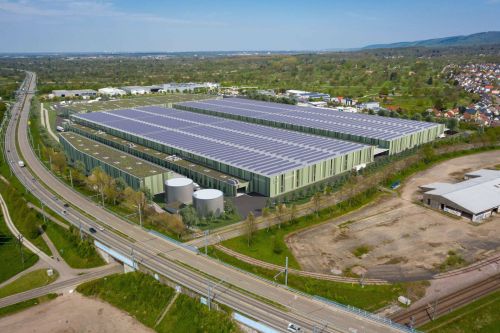The shed’s the star
Investment & finance
In CBRE’s annual EMEA Investor Intentions Survey published earlier this year, the largest number of the European investors surveyed (33 pct) expressed a preference for industrial properties, thus “reaffirming its status as an institutional asset class” – in the words of the report. This sentiment is also being reflected in the data for investment volumes, according to Savills’ latest ‘Think Outside the Big Box’ report on the warehousing market: “No longer the poor relation to offices and retail, the logistics sector accounted for a record GBP 37 bln [EUR 41.6 bln] of capital deployed in commercial real estate in 2017 across Europe., representing a fifth of all investment (…) and setting a new record,” reads the report. But what lies behind this shift in investor sentiment and how significant is it for the CEE region?
In the opinion of Peter Kunz, the EMEA head of industrial and logistics at Colliers International, it is very significant – and there are two reasons why: “Firstly, international standards have now been firmly established for such parameters as ceiling heights and loading docks, so it’s easier to understand what the position of properties is. This makes it more profitable to trade big box assets,” he explains. The second reason, he says, is the demand from tenants: “Particularly from the e-commerce segment, as the demand from customers for their services grows. With there now being big investors with money to spend in the market, along with the huge demand and low vacancy, everything in the warehouse investment market is running at full power. A few years ago there was no e-commerce and no big boxes – we didn’t have this kind of volume just six or seven years ago. What we are seeing is a worldwide phenomenon, led by such players as Amazon, of course.”

Peter Kunz, the EMEA head of industrial and logistics at Colliers International
Paweł Nowakowski, the head of capital markets at Cresa’s Warsaw office, believes that in Poland there are also other reasons, connected with the wider economy, for why the sector has been climbing up the investment agenda. “In general, it’s because of the favourable macro-economic situation. Growing private consumption, the expansion of e-commerce, retail and manufacturing as well as the increased inflow of foreign direct investment, are the main drivers for the development of the warehouse business in Poland. All of this – combined with further improvements to Poland’s road and transportation infrastructure and recent legislative changes facilitating access to corporate income tax exemptions across Poland – should continue to stimulate warehouse investment in the near future.” Does what we are seeing represent a marked shift away from other asset classes? In Peter Kunz’s view, only to some extent: “I think the office investment market is still solid, since it is the best known and most developed. There is a little bit of a question mark over retail, however. There must be an impact on it from e-commerce, so some retailers are struggling and this is having an effect on rents. This means that logistics yields are higher than for retail, making warehousing a more tempting investment product. I don’t think investors are turning away from retail exactly, but there is a definite question over rents and whether tenants can continue to pay,” he feels, adding that: “Consumer habits are now more mobile and digital compared to classic retail – and this is especially true for younger generations of consumers. This trend will only continue, further establishing warehousing as an asset class, since it is required to serve this demand.” When it comes to the attractiveness of industrial yields, Paweł Nowakowski concurs: “The numbers speak volumes! When you look at the prime yields on the market, they are now hovering at around 4.5 pct in the office and retail segment. In logistics, prime yields are at around 6.5 pct. The stable economic growth and steady development of the real estate market in Poland has changed investor perceptions and positioned our country as a developed and mature market. A natural consequence of this is the compression of yields in all market segments. Institutional investors are thus taking a closer look at the logistics segment in Poland and are attracted by the strong and sustainable income streams backed by relatively high investment returns.” According to the latest RCA figures, the yield gap between CEE markets and Western Europe has widened over the last two years, with the cap rate for CEE industrial assets now standing at just over 6 pct compared to around 5 pct in Western Europe and just over 3 pct in the UK – putting the spread between UK and CEE yields at a record 276 bps. RCA’s and Savills’ figures also show that while around GBP 14 bln [EUR 15.7 bln] was invested in UK industrial asset transactions in 2017 (and EUR 9.2 bln in Germany and EUR 5.6 bln in France), Poland still lags behind at EUR 1.1 bln.
The biggest boost to warehouse investment is clearly coming from the burgeoning e-commerce sector, which has also been transforming both the nature of warehouse operations and where they are located. “Automation and e-commerce are global trends that do not seem to be stopping or slowing down. The e-commerce business is inextricably linked with the warehouse sector, being essential for its supply chains. As online retail develops and as operators aim to shorten delivery times and increase volumes, the demand for facilities close to densely populated areas has risen significantly. Even the giants in the market are taking a step forward in this respect. For example, the world’s largest e-commerce company, Amazon, has announced the launch and roll-out of a package-delivery service to compete with FedEx and UPS,” explains Paweł Nowakowski.
Enter the giants
Amazon itself dramatically put the spotlight on the CEE region’s warehousing scene by opening huge distribution centres on the outskirts of Wrocław, Poznań, Szczecin, Sosnowiec, Prague and Sereď (Slovakia) in recent years. Its 161,500 sqm fully-automated fulfilment centre in Szczecin was sold by Invesco to Vestas IM this summer, following GLL Hana Private Real Estate’s purchase of Amazon centres in Poznań and Wrocław in 2016 and AEW Europe’s acquisition of the Prague airport centre a year earlier. The main advantage of such facilities is that they are handy for distribution to Western European end-consumers without the need to pay Western rents and other costs. “The price levels in the Czech Republic are still lower and labour is still cheaper, so it is still a very attractive market for logistics. If there is good product available, investors will be happy to buy it – and this especially applies to such locations as Plzeň and close to Bavaria,” claims Peter Kunz.
As Paweł Nowakowski sees it, there are no clouds on the horizon for the Polish warehouse investment market – and things, if anything, can only get better, especially since Poland does not suffer from a lack of new locations: “Occupier demand is very strong – and not only in the larger cities. It has been spreading across the country, including new locations on the Polish logistics map, such as Olsztyn, Kielce, Zielona Góra and Białystok. This means there will be no lack of suitable investment products with strong covenants and attractive yields, thus sustaining the warehouse investment market on its upward path,” he argues.
Are there no issues, then, that investors need to consider before taking the plunge into the Polish or Czech industrial markets? “There is a lack of land for new warehousing development in the Czech Republic. This is not a problem in Poland, but the main issue here is the shortage of labour. So bottlenecks could form in the construction of big warehouses and this could limit the number of assets that can be bought,” admits Peter Kunz.
Despite the advantages that have been listed for our region, Western Europe is nevertheless still very attractive for companies to locate in – Germany was actually voted the number one logistics location by the World Bank recently. But e-commerce continues to boom it brings with it the need to keep down costs and the prices of goods, making our part of the world much more desirable to industrial asset investors. ν






















































